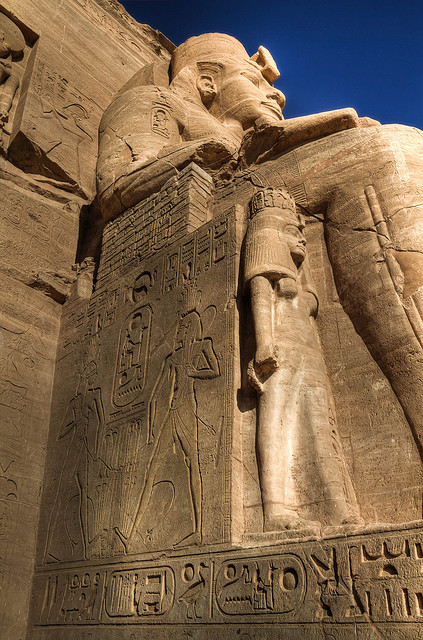The Phenomenon of Abu Simbel Posted by Fisal on Nov 10, 2012 in Arabic Language, Culture, Grammar, Pronunciation, Vocabulary
The two temples at Abu Simbel أبو سمبل are among the most magnificent monuments آثار in the world. Their removal and reconstruction was a historic event in itself. When the temples (280 km from Aswan) were threatened by submersion الغمر – الغرق in Lake Nasser, due to the construction of the High Dam السد العالى , the Egyptian Government asked for the support of UNESCO اليونسكو and launched a world wide appeal. During the rescue operation عملية إنقاذ which began in 1964 and continued until 1968, the two temples were dismantled and raised over 60 meters up the sandstone cliff where they had been built more than 3.000 years before. There, they were reassembled, in the exact same relationship to each other and the sun, and covered with an artificial صناعى mountain. Most of the joins in the stone have now been filled by antiquity experts خبراء , but inside the temples it is still possible to see where the blocks were cut. You can also go inside the man-made dome and see an exhibition معرض of photographs showing the different stages of the massive removal-reconstruction process.
The Temple of Re-Harakhte (The Sun Temple of Ramsis II):
The main temple was dedicated to Ramsis II and to the four universal gods آلهة Ptah, Re-Harakhte, Amun-Re, and to Ramsis II himself. Of the seven temples he built, Abu Simbel is considered to be the most impressive.
Above the doorway مدخل in a niche, stands the sun god, a falcon headed representation of Ramsis, holding a war-scepter which shows the head and neck of an animal which is read as user, in his right and a figure of Ma’at in his left. This setup ingeniously creates the Kings Throne عرش name of User-Ma’at-Re. At the top of the facade is a row of apes which are thought to be greeting the morning sun and indeed the monument looks best at that time. The sides of the thrones next to the entrance are decorated with Nile gods symbolically uniting Egypt, while below are prisoners, representing conquered nations الأمم المهزومة , to the left, African and to the right, Asian.
The entrance leads into a Grand Hall which is 57 feet high and 52 feet wide and was cut from the rock. It is supported with eight pillars with statues تماثيل of Ramsis.
To either side of the Grand Hall are smaller rooms, two to the South الجنوب and four to the North الشمال . Most suggest that these rooms were for storage التخزين (treasure كنز rooms) but elsewhere it is suggested that they were used for festivals مهرجانات related to the Kings Jubilee.
Beyond the Grand Hall is the second hypostyle hall with its flowered pillars أعمدة . Scenes in this hall show the King and his wife, Nefertari نفرتارى making offerings to Amun and Re-Harakhte (the Sun God), and beyond that is the three chapels, the central one containing the four deities worshipped in the temple (including Ramsis II).
The sun shines on the face of the statue on February 22 and October 22 every year, the birthday and the coronation date of Ramses II.

Build vocabulary, practice pronunciation, and more with Transparent Language Online. Available anytime, anywhere, on any device.
About the Author: Fisal
Well, I was born near the city of Rasheed or Rosetta, Egypt. Yes, the city where the Rosetta Stone was discovered. It is a small city on the north of Egypt where the Nile meets the Mediterranean. I am a Teacher of EFL.




